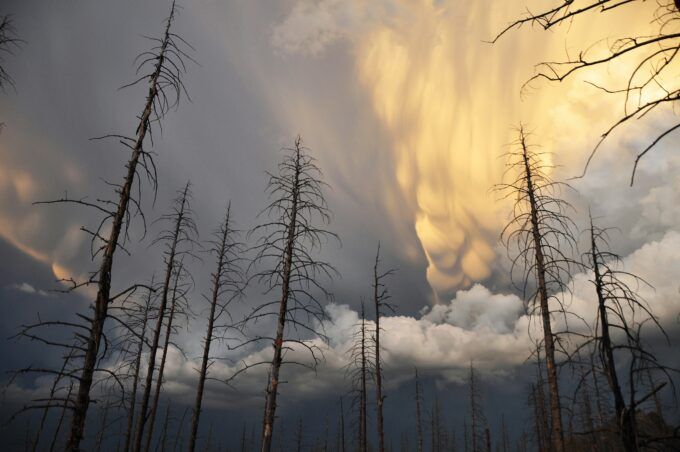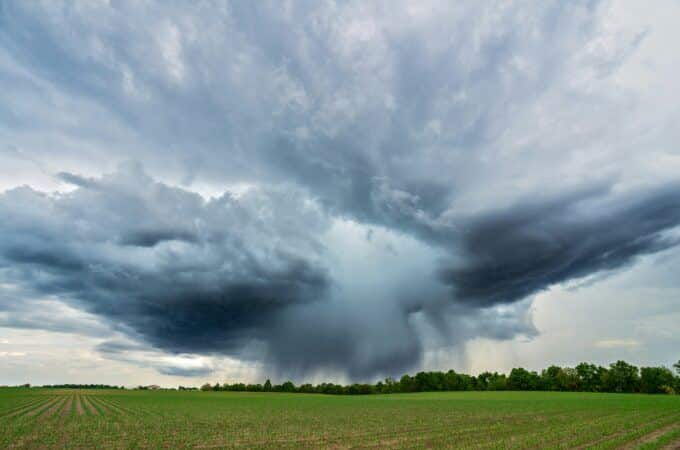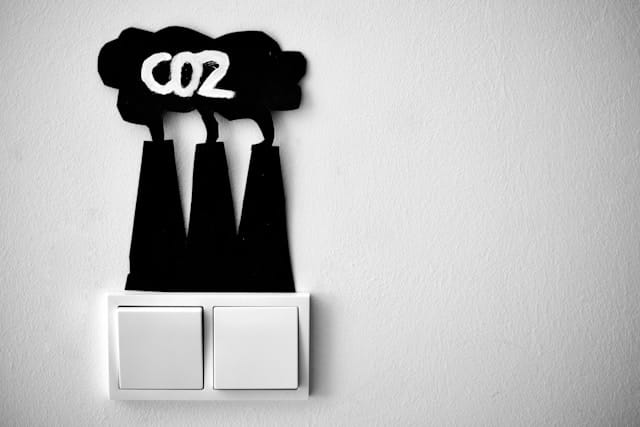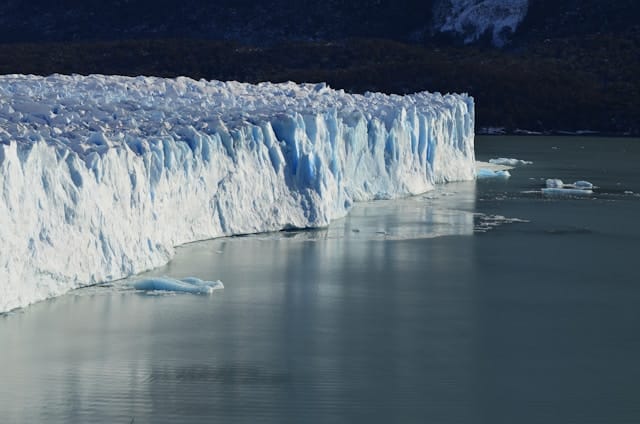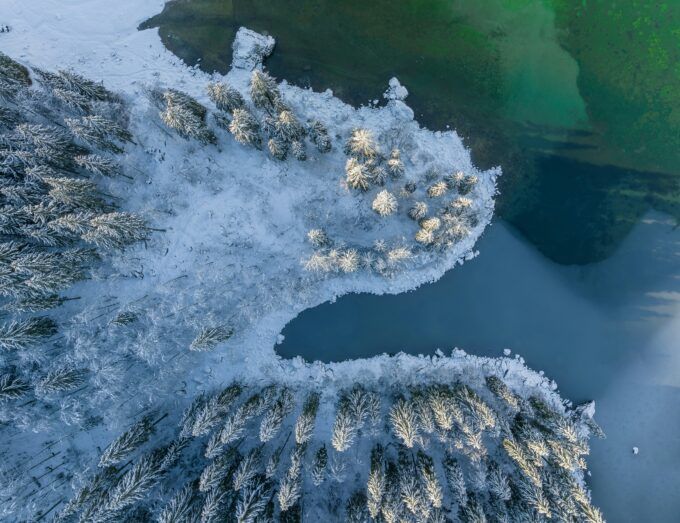
Permafrost Showdown
By Robert Hunziker
“Deep below the glistening surface of a frozen Arctic lake, something is bubbling—something that could cause global warming to accelerate beyond all previous projections… Now the freezer door is opening, releasing the carbon into Arctic lake bottoms. Microbes digest it, convert it to methane, and the lakes essentially burp out methane.’ Scientists estimate that permafrost holds up to 950 billion tons of carbon. As it thaws, 50 billion tons of methane could enter the atmosphere from Siberian lakes alone. That’s ten times more methane than the atmosphere holds right now,” (Katey Walter Anthony, biogeochemist, National Geographic Explorer Since 2011)
Rapid warming of Arctic permafrost has brought a significant threat to all life forms. Consequently, The Royal Society (est. 1660) felt compelled to support publication of a new video that exposes this threat: What Happens When the Permafrost Thaws? BBC in partnership with The Royal Society by Daniel Nils Roberts, British-Norwegian director, April 15, 2024.
“Thermokarst lakes (formed when permafrost melts) are projected to release approximately 40% of ancient permafrost soil carbon emissions this century.” (Source: K.M. Walter Anthony, et al, Decadal-scale Hotspot Methane Ebullition Withing Lakes Following Abrupt Permafrost Thaw, Environmental Research Letters, Vol. 16, No. 3, 2021)
“The Tibetan Plateau is the largest alpine permafrost region in the world, accounting for approximately 75% of the total alpine permafrost area in the Northern Hemisphere. Similar to high-latitude permafrost regions, this region has experienced fast climate warming and extensive permafrost thaw, which has triggered the widespread expansion of thermokarst lakes and other types of abrupt permafrost thaw. The number of thermokarst lakes in this permafrost region is estimated to be 161,300.” (Source: Guibiao Yang, et al, Characteristics of Methane Emissions from Alpine Thermokarst Lakes on the Tibetan Plateau, Nature Communications 14, Article No. 3121, 2023)
Ecosystems throughout the planet are rapidly transforming because of human-generated global warming. After all, what does the formation of 161,300 thermokarst lakes in only the Alpine permafrost region alone say about the impact of global warming?
Scientists are expressing renewed concerns about monster climate events lurking beneath the frozen ground of permafrost, which is 15% of the exposed land surface of the Northern Hemisphere (MIT Climate Portal). And monsters lurk above solid grounding in Antarctic glacial formations, starting to fracture as fissures widen like ogres of the deep.
From the Arctic to Antarctica the planet is sagging, dripping, slouching, changing the face of 10,000 years of nature coexisting with humanity side-by-side until only recently as it transforms into an adversarial relationship. Permafrost ranks alongside the Arctic, Antarctica, Greenland, The Great Barrier Reef, and the world’s three largest rainforests as the most important determinates of this changing future. Within permafrost’s confines exist thousands of years of latent ingredients that have the potential to set the world on fire. Its impact could be transcendent.
“Most of Earth’s near-surface permafrost could be gone by 2100, an international team of scientists has concluded after comparing current climate trends to the planet’s climate 3 million years ago… The team found that the amount of near-surface permafrost could drop by 93% compared to the preindustrial period of 1850 to 1900. That’s under the most extreme warming scenario in the latest report of the Intergovernmental Panel on Climate Change.” (Source: Study: Near Surface Permafrost Will Be Nearly Gone by 2100, Geophysical Institute, University of Alaska, Fairbanks, Sept. 15, 2023)
What Happens When the Permafrost Thaws (the film): “Permafrost is of huge importance to the entire planet… including one-half of Canada and two-thirds of Russia… and the Tibetan Plateau… permafrost is rock, sediment or ice that remains at or below zero degrees Celsius for two or more consecutive years… depending upon where it is found, permafrost can be millions of years old.”
Interviews in the What Happens film, living in permafrost regions, like Svalbard, Norway, when discussing noticeable climate change: “This kind of weather, it’s not supposed to be like this in October, it’s supposed to be minus 15°, clear, dry climate, and it’s not. It’s a rainstorm.”
As a result of abnormal climate behavior, especially where permafrost hangs out, the “active layer” of permafrost is getting deeper and deeper throughout the world. This is bad news. This creates more and more exposure to thousands of years of accumulation of “who knows what?” It’s happening at a fast enough rate now that it could expose 10,000,000 woolly mammoths (a very rough estimate by somebody?) as well as ancient viruses, and who knows what else?
Moreover, aside from 10,000,000 woolly mammoth skeletons with some of them kinda well-preserved skin, fur, etc., a unique study claims up to 20,000 toxic contamination sites could be exposed: “Here we identify about 4500 industrial sites where potentially hazardous substances are actively handled or stored in the permafrost-dominated regions of the Arctic. Furthermore, we estimate that between 13,000 and 20,000 contaminated sites are related to these industrial sites.” (Source: Moritz Langer, et al, Thawing Permafrost Poses Environmental Threat to Thousands of Sites with Legacy Industrial Contamination, Nature Communications, March 28, 2023)
“But there’s something else that concerns scientists much more. The scariest thing that is happening with permafrost is what it is doing to the climate itself… permafrost acts as a storage… it locks up the carbon from dead vegetation quite effectively, and it’s accumulated over many thousands of years.” (What Happens).
Now, the freezer door is open. Nobody knows for sure what’ll come through. But the biggest concern is permafrost competing with human-driven carbon emissions like CO2. This could drive global warming to unspeakable levels.
“There’s estimated to be four times the amount of carbon in permafrost than all the human-generated CO2 emissions in modern history. The release into the atmosphere of even a fraction of this as carbon dioxide and methane will have a profound impact on the climate.” (What Happens)
“What can be done” is an open question that’s semi-addressed in the film What Happens: We can make more informed decisions and build communities that are resilient to changes, highlighted by the ways that humans are entangled with nature. In other words, adaptation is the most realistic solution, other than stopping fossil fuels, which is not happening.
Meanwhile, the backup position to frustration over ongoing CO2 emissions that are continuing to ratchet up, now at all-time highs, scientists are increasingly calling for “adaptation to climate change” instead of pounding the table for a halt to emissions. For example, a recent report by the prestigious Columbia Climate School makes the case: “Experts are warning that policymakers should consider adaptation to sea-level rise a primary concern.” But, how to adapt to permafrost thaw is an altogether different matter… the most challenging of all.
In truth, climate change is far ahead of schedule, as scientific models of yesteryear look like distant history. It’s likely that history will designate the 21st century “The Age of Adaptation” by default as countries react, after the fact, to collapsing ecosystems, which guarantees a future full of surprises beyond wildest imagination.
There are scientists who believe permafrost thawing will accelerate global warming beyond the comfort zone of life in several regions of the planet, in fact, it’s already very close to a large scale event in Pakistan, India’s Indus River Valley, eastern China, and sub-Saharan Africa.
Still, regardless of circumstances, finding a way forward to the future is in the lifeblood of humanity. In that regard, there is some good news (kinda good): According to the International Energy Agency (IEA) renewables will meet 35% of “global power generation” by 2025, thus a significant rise in CO2 emissions from global power activity is unlikely over the next few years. However global power generation is not the full enchilada of world energy: Along those lines, coal consumption is expected to drop 13.5% by 2030 but natural gas and oil will both rise as renewables, alongside fossil fuels, experience strong growth to meet increasing levels of demand. According to the IEA, fossil fuels will still account for 70% of world energy, down from today’s 82%, by 2030. This is progress but is it too slow, not enough soon enough? Moreover, and as endorsed by several oil CEOs, the IEA expects oil supply to remain robust into 2050. Hmm -global warming is all about excessive levels of fossil fuel CO2 emissions. Those emissions are not going away anytime soon, which will please the permafrost thawing gods.
As for US influence to lessen the impact of permafrost thawing, although not expressly stated as such in the legislative bill, the Inflation Reduction Act (IRA) provides $370 billion in clean energy investments. But can Biden’s IRA survive political wars? Is IRA bulletproof? More importantly, is it enough soon enough?
According to Barron’s d/d April 1, 2024: Trump Is Taking Aim at Biden’s Climate Law: He calls it a waste of money, and instead, has promised oil and gas CEOs favorable treatment, including scrapping Biden’s IRA, if elected, assuming they pony-up $1 billion for his campaign. Is this a bribe? It’s MAGA’s BMGW “Buy More Global Warming” to subsidize thawing of permafrost.
THE END
—————-
This article was originally published on May 17, 2024 © Counterpunch
Robert Hunziker lives in Los Angeles and can be reached at [email protected].
Note: This article will also be posted on the Facing Future Now! Facebook group. If you would like to comment on this article, please go to the Facebook group and post your comments there under the article posting.
Facing Future Now! https://www.facebook.com/groups/530755592068234






